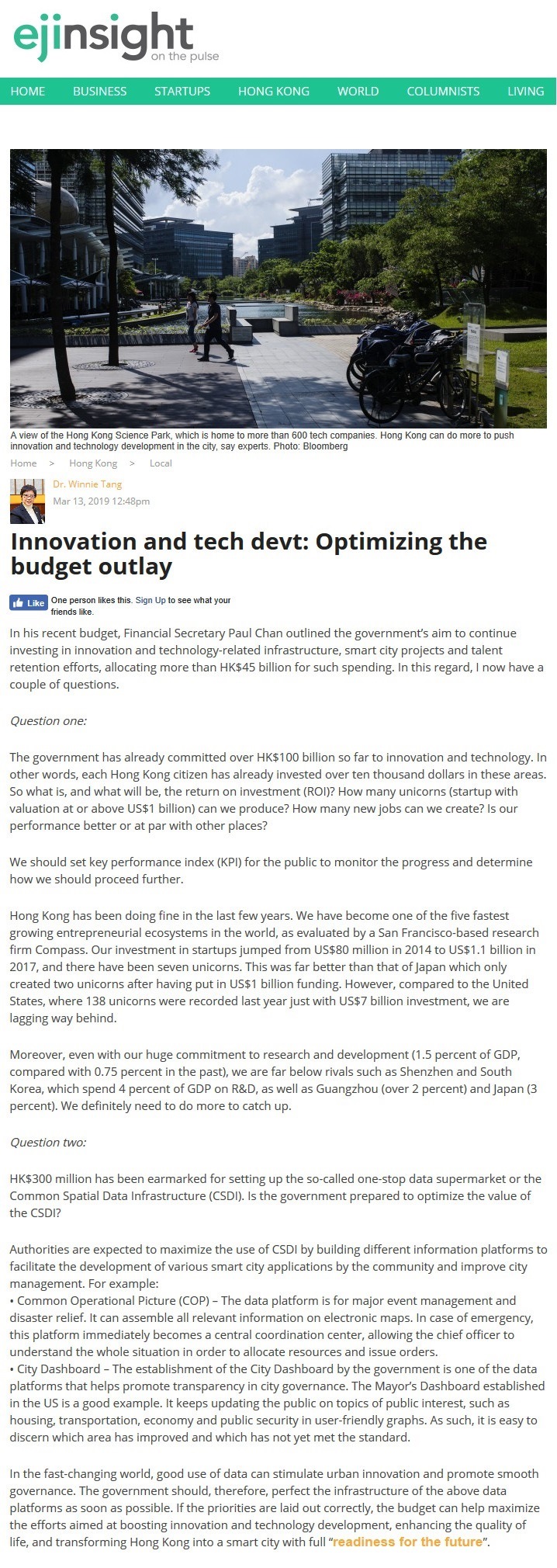網上版請按此

Innovation and tech devt: Optimizing the budget outlay
In his recent budget, Financial Secretary Paul Chan outlined the government's aim to continue investing in innovation and technology-related infrastructure, smart city projects and talent retention efforts, allocating more than HK$45 billion for such spending. In this regard, I now have a couple of questions.
Question one:
The government has already committed over HK$100 billion so far to innovation and technology. In other words, each Hong Kong citizen has already invested over ten thousand dollars in these areas. So what is, and what will be, the return on investment (ROI)? How many unicorns (startup with valuation at or above US$1 billion) can we produce? How many new jobs can we create? Is our performance better or at par with other places?
We should set key performance index (KPI) for the public to monitor the progress and determine how we should proceed further.
Hong Kong has been doing fine in the last few years. We have become one of the five fastest growing entrepreneurial ecosystems in the world, as evaluated by a San Francisco-based research firm Compass. Our investment in startups jumped from US$80 million in 2014 to US$1.1 billion in 2017, and there have been seven unicorns. This was far better than that of Japan which only created two unicorns after having put in US$1 billion funding. However, compared to the United States, where 138 unicorns were recorded last year just with US$7 billion investment, we are lagging way behind.
Moreover, even with our huge commitment to research and development (1.5 percent of GDP, compared with 0.75 percent in the past), we are far below rivals such as Shenzhen and South Korea, which spend 4 percent of GDP on R&D, as well as Guangzhou (over 2 percent) and Japan (3 percent). We definitely need to do more to catch up.
Question two:
HK$300 million has been earmarked for setting up the so-called one-stop data supermarket or the Common Spatial Data Infrastructure (CSDI). Is the government prepared to optimize the value of the CSDI?
Authorities are expected to maximize the use of CSDI by building different information platforms to facilitate the development of various smart city applications by the community and improve city management. For example:
• Common Operational Picture (COP) – The data platform is for major event management and disaster relief. It can assemble all relevant information on electronic maps. In case of emergency, this platform immediately becomes a central coordination center, allowing the chief officer to understand the whole situation in order to allocate resources and issue orders.
• City Dashboard – The establishment of the City Dashboard by the government is one of the data platforms that helps promote transparency in city governance. The Mayor's Dashboard established in the US is a good example. It keeps updating the public on topics of public interest, such as housing, transportation, economy and public security in user-friendly graphs. As such, it is easy to discern which area has improved and which has not yet met the standard.
In the fast-changing world, good use of data can stimulate urban innovation and promote smooth governance. The government should, therefore, perfect the infrastructure of the above data platforms as soon as possible. If the priorities are laid out correctly, the budget can help maximize the efforts aimed at boosting innovation and technology development, enhancing the quality of life, and transforming Hong Kong into a smart city with full "readiness for the future".
Dr. Winnie Tang
Adjunct Professor, Department of Computer Science, Faculty of Engineering and Faculty of Architecture, The University of Hong Kong